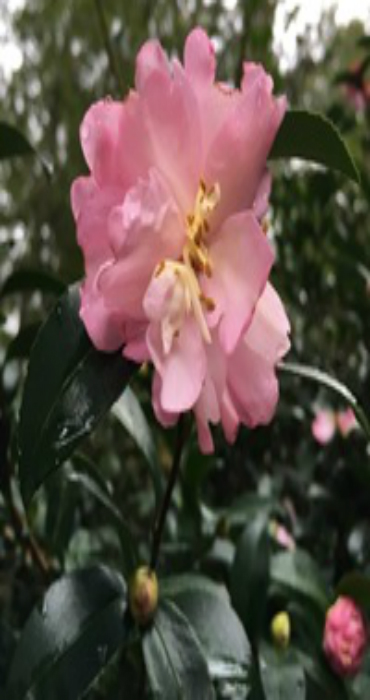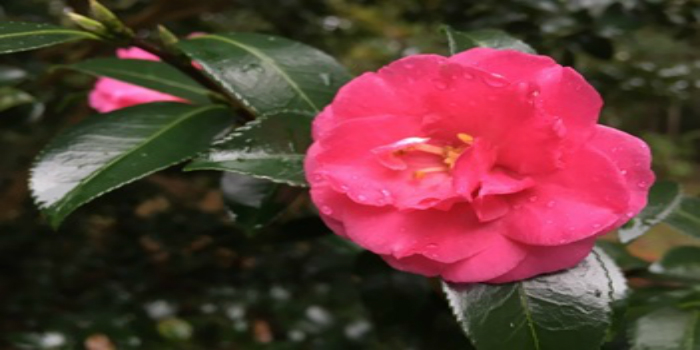Ask Master Gardener Volunteer JoAnn Green
After enjoying the lovely colors of wildflowers and leaves changing in September and October, there are few plants in my landscape that offer a punch of color in late fall like camellias. I planted a large bed of sasanqua camellias for my husband whose birthday is in November in hopes that we could celebrate him with flowers each year. Those ‘Shishi-gahira’ and ‘Cotton Candy’ camellias have not let me down in over 20 years!
Shade-Loving Camellias
Camellias do well in part shade (https://edis.ifas.ufl.edu/pdffiles/EP/EP00200.pdf ) My one Japonica camellia gets about 5-6 hours of  mid-morning to mid-afternoon sun. This large shrub is growing next to our back porch and the top is taller than the gutters! The morning shade comes from tall trees to the east, and our house on the west side gives late afternoon shade to the shrub, so the part-sun comes from late morning to early afternoon. Our Japonica camellia is a Gigantea variety and it never fails to provide us with many lovely blooms in late December through January. (Photo by J. Green: Sasanqua camelia, ‘Cotton Candy.)
mid-morning to mid-afternoon sun. This large shrub is growing next to our back porch and the top is taller than the gutters! The morning shade comes from tall trees to the east, and our house on the west side gives late afternoon shade to the shrub, so the part-sun comes from late morning to early afternoon. Our Japonica camellia is a Gigantea variety and it never fails to provide us with many lovely blooms in late December through January. (Photo by J. Green: Sasanqua camelia, ‘Cotton Candy.)
The sasanqua camellias are under a broader tree canopy. In one bed, the shrubs (Cotton Candy) have reached over 6 feet. They receive dappled shade throughout the day but no direct sun. The flowers are a light pink and the shrub’s height makes them a nice backdrop for lower growing shrubs in the landscape. In the other bed the Shishi-gahira camelias are not as tall, about 3 ½ to 4 feet in height. These shrubs get between 3-4 hours of direct sun in afternoon. Both varieties offer an early profusion of blooms throughout the month of November.
Soil and Water Needs
 Camellias prefer a slightly acidic soil (pH 5.0 to 6.5), high in organic matter (https://edis.ifas.ufl.edu/pdffiles/EP/EP00200.pdf ). The University of Florida publication also recommends preparing the entire bed with organic material, and not just the planting hole. The winter months are best for planting new camellia plants so their root system can become established before the summer heat. Be sure to plant camellias at the right depths – with the root ball at least 2 inches above the soil line. Mulch the beds after planting to protect the exposed root ball and help conserve moisture. (Photo by J. Green. Sasanqua camelia “Shishi-gahira’) Newly planted camellias will need watering two to three times a week until established. They are fairly drought resistant but will need watering every week to 10 days during extended periods of drought. During flowering, be sure your camellias receive at least an inch of water each week.
Camellias prefer a slightly acidic soil (pH 5.0 to 6.5), high in organic matter (https://edis.ifas.ufl.edu/pdffiles/EP/EP00200.pdf ). The University of Florida publication also recommends preparing the entire bed with organic material, and not just the planting hole. The winter months are best for planting new camellia plants so their root system can become established before the summer heat. Be sure to plant camellias at the right depths – with the root ball at least 2 inches above the soil line. Mulch the beds after planting to protect the exposed root ball and help conserve moisture. (Photo by J. Green. Sasanqua camelia “Shishi-gahira’) Newly planted camellias will need watering two to three times a week until established. They are fairly drought resistant but will need watering every week to 10 days during extended periods of drought. During flowering, be sure your camellias receive at least an inch of water each week.
Pest Problems
The main pest that I have had to deal with is tea scale on the Japonica camellia. I follow the University of Florida recommendations if I see signs of tea scale and use horticultural oil in the spring after the shrub is finished flowering. The link to the University of Florida publication offers details about other pests – aphids and mites, and diseases that affect camellias. I have been fortunate in only having to deal with tea scale. I have heard from other gardeners that deer can be a problem with stripping leaves from the shrubs. A few years ago, I planted the ‘Yuletide’ variety of sasanqua camellias and soon afterwards learned that the deer seemed to enjoy this particular variety! I now have a chicken wire cage around this camellia and so far, the plant is growing well in the landscape. The dear have not touched the ‘Shishi-Gahira’ or the ‘Cotton Candy’ varieties of sasanqua and they have not bothered with the japonica camelia. (Maybe these taste like broccoli!) If you are subject to deer in your landscape, I recommend starting with one or two plants to see if they might be a ‘menu item’ before you commit to a mass planting!
If you have any questions or suggestions for future articles please email to wakullamg@ifas.ufl.edu
| The Institute of Food and Agricultural Sciences (IFAS) is an Equal Opportunity Institution authorized to provide research, educational information, and other services only to individuals and institutions that function with non-discrimination with respect to race, creed, color, religion, age, disability, sex, sexual orientation, marital status, national origin, political opinions, or affiliations. U.S. Department of Agriculture, Cooperative Extension Service, University of Florida, IFAS, Florida A&M University Cooperative Extension Program, and Boards of County Commissioners Cooperating |
 0
0



